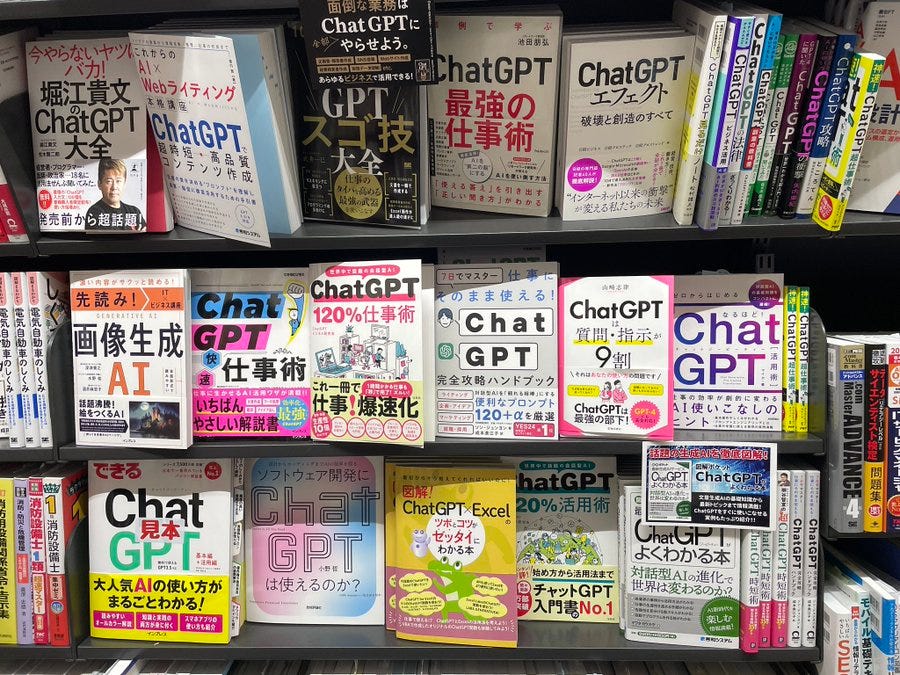Blurred realities (022)
Exploring many kinds of human-machine augmentation feat. an exclusive interview with Inês Santos Silva.
Happy Monday and greetings from a muggy London. I am here this week together with the TrendWatching crew to talk about Centaurs and technology trends tomorrow at the Barbican. To say I’m excited would be an understatement – London is where Envisioning effectively began a decade ago, and where I had some of my first opportunities to develop and present ideas about the emerging future of technology.
One of the ideas we’ll be exploring at the session are “creative centaurs”, or using machine intelligence in order to augment our ability to come up with new and unexpected ideas.
We at Envisioning have been developing an AI-augmented co-creation interface and are exploring different application areas for this. One of the more surprising use cases has been around the 🌸 Ikigai – or finding out what gives people a sense of purpose or reason for living. We have created an approach which allows you to input things you love, are good at, can be paid for, and that the world needs, while having GPT increase your scope, identify intersections and eventually propose a unique Ikigai for you. If this is something you want to experiment with, please reply to this message so we can add you to the next cohort in the coming weeks.
This week’s edition is short and sweet and features an interview with a dear friend and cofounder of the Portuguese Women in Tech movement and AthenaDAO, Inês Santos Silva about her use of AI today. As always, please like, share and subscribe to show your appreciation of Artificial Insights!
MZ
Embracing hallucinations 👁️
Last week at Lisbon Futures Friends I learned about DreamGPT which aims to enhance the creative potential of LLMs by simulating a dreaming process, unlocking new levels of innovation and creativity in AI systems. DreamGPT is designed to simulate a dreaming process for LLMs, allowing them to explore information in a more chaotic and experimental way.
Awake learning: user inputs a problem or topic and DreamGPT expands and internally debates approaches using multiple AI agents.
Dreaming: rearranges broken down memory randomly and makes free associations with words while creating an original story.
Patterns: creates new perspectives on the input topic which the user can provide feedback about.
Simulating psychedelics with LLMs 🍄
In a similar vein, Twitter user Katan’Hya noticed that LLMs can believably simulate the verbal and cognitive effects of taking specific psychedelics. Their training data includes, among other sources, the entire corpus of Erowid trip reports
Wearable AI pin from Humane 🧷
Designer Coperni featured Humane's mysterious AI Pin during last week’s Paris Fashion Week. While the device's functionality remains unclear, its appearance has sparked curiosity. Questions about its capabilities and competition from industry players like Jony Ive and OpenAI loom large.
Tech Meets Fashion: The blend of high-tech devices with high fashion during a high-profile event like Paris Fashion Week makes it unique.
Mystery Factor: The enigmatic nature of Humane's AI Pin adds an element of intrigue, as its features and capabilities are still undisclosed.
Industry Competition: The mention of potential competitors like Jony Ive and OpenAI in the wearable tech space adds a layer of complexity and anticipation.
Data-driven creativity 🧢
Article in the Guardian discussing how AI is revolutionizing the fashion industry by assisting in trend forecasting. Utilizing big data and machine learning, AI can identify emerging trends from runway shows and social media far quicker and more accurately than traditional methods. This not only has implications for profits but also sustainability, as accurate predictions minimize waste.
Profit & Sustainability: AI can save the fashion industry money and make it more eco-friendly by reducing inaccurate predictions that lead to overproduction and waste.
Complex Variables: Fashion is influenced by an intricate set of variables like social movements and emotions, which makes AI's capability to analyze large datasets particularly valuable.
Human-AI Synergy: Despite AI's quantitative strengths, the article emphasizes the continuing role of human intuition and expertise in capturing the emotional and cultural dimensions of fashion trends.
First impressions with GPT-4V(ision) 👀
OpenAI's new features for GPT-4 enable multimodal interactions, allowing the model to handle both text and image inputs. This article by James Gallagher and Piotr Skalski outlines experiments testing the model's abilities in Visual Question Answering (VQA), Optical Character Recognition (OCR), math problem-solving, object detection, and even CAPTCHA interpretation.
Multimodal Abilities: GPT-4's move into handling multiple types of input, like text and images, represents a significant leap in AI capabilities.
Versatility: The tests range from object recognition to answering questions about movies, showcasing the model's broad range of applications.
Limitations Highlighted: The article does an excellent job in pointing out where GPT-4V excels and where it falls short, giving a rounded view of the model's capabilities.
GPT-4V in the wild
Emerging Vocabulary
Base Model
A pre-trained model which has been developed and optimized to solve a particular task, set of tasks, or to understand a specific type of data. It serves as a starting point or a foundation for further design and development. These models are typically trained on large datasets and require significant computational resources to develop. Leveraging a base model is a typical approach in transfer learning, which allows for the reutilization of pre-existing models on newer tasks. This approach helps to cut costs, save time in training and data collection, and, in many cases, can lead to better performance.
View all emerging vocabulary entries →
Interview
Ethical awareness and action
This week’s interview is with a friend and fellow Porto resident Inês Santos Silva. She fights for gender equality in health care, tech, and business and is an established entrepreneur. I have known Inês a while and can genuinely say she was an inspiration for getting this newsletter off the ground earlier this year. You should follow her on Twitter and LinkedIn.
What excites and concerns you about AI?
What excites me about AI is its potential to drive significant advancements in various fields. It can be pivotal in curing diseases by accelerating medical research and enhancing diagnostic accuracy. AI's capacity to analyze massive datasets can help us better understand the universe, unraveling cosmic mysteries and expanding our knowledge of ourselves. Additionally, AI has the potential to free us from mundane, repetitive tasks, allowing humans to focus on more creative and fulfilling endeavors, which could ultimately lead to a more innovative and personally rewarding society.
However, I also have concerns about AI. The transition from a society heavily dependent on traditional forms of work to one where AI assumes a more central role, will be complex and hard. Ensuring that this shift is equitable and that people have opportunities for retraining and upskilling is crucial to prevent widespread economic disparities. The rapid disruption caused by AI can lead to job displacement and economic instability if not carefully managed. Striking a balance between technological progress and social stability is imperative.
Which aspects (or dimensions) of inclusivity should AI consider?
This is another area of concern for me. AI is currently being trained on highly biased training data, exacerbating the bias and inequalities in the world. Biased training data, combined with a lack of diversity in AI development teams, can lead to unjust outcomes in areas like hiring, criminal justice, and healthcare, further deepening societal divisions. Addressing this issue is essential to ensure AI technology is both fair and ethical.
How would you make AI more balanced?
We need to make sure we stop that and build AI that has no bias towards gender, ethnicity, age, sexuality, and others. The Algorithmic Justice League is a fantastic organization working to illuminate the social implications and harms of artificial intelligence. We need more organisations working in this field. And we probably need regulation. However, I foresee a challenging path to regulate AI in general.
What has entrepreneurship taught you about the moment we are living through?
I started exploring the area of entrepreneurship in 2009/2010 when a new wave of entrepreneurs, tools, and methodologies (lean startup, business model canvas, AWS, etc) were getting started. From that time, I learned that it takes time to develop the best use cases and business models. We never know what will work and won’t. And if you want to do something in the area, you can’t wait. You need to be in the trenches, trying, connecting with others, sharing, and learning. That’s where big ideas come from.
How are you using AI yourself today?
I use Chat-GPT many times during the day. Sometimes, I don’t want to start writing an article/document/email from a blank page, so I ask chat GPT for help.
Sometimes, I use it to take my brainstormings further. To outline workshops and facilitation sessions. And to re-write content that I’ve produced in a different voice, and I use Midjourney and Dall-E for illustrations.
If Artificial Insights makes sense to you, please help us out by:
Subscribing to the weekly newsletter on Substack.
Following the weekly newsletter on LinkedIn.
Forwarding this issue to colleagues and friends.
Sharing the newsletter on your socials.
Commenting with your favorite talks and thinkers.
Artificial Insights is written by Michell Zappa, CEO and founder of Envisioning, a technology research institute.
You are receiving this newsletter because you signed up on envisioning.io.





I agree with Inês Santos Silva's thoughtful perspective on AI and entrepreneurship. Her recognition of AI's transformative potential and the importance of addressing biases align with the critical considerations of our rapidly evolving technological landscape. Great interview!